skip to main |
skip to sidebar
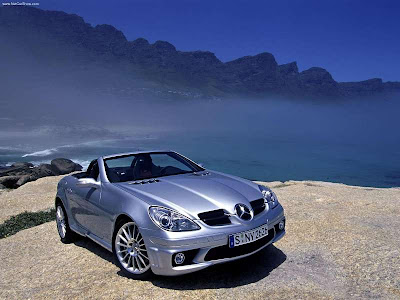



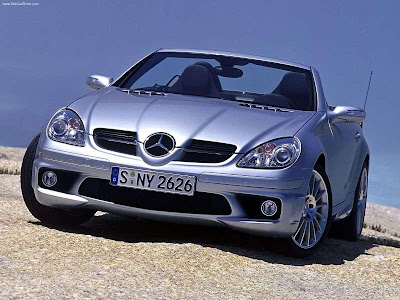




Mercedes-Benz SLK55 AMG
The CLS Coupé, SLK Roadster and new-generation C-Class: Mercedes-Benz celebrates three world premieres at the International Motor Show in Geneva
Stuttgart, Feb 20, 2004
Mercedes-Benz will use the 74th International Motor Show in Geneva to showcase the latest results of its second strategic product initiative. Three new Mercedes models will celebrate their world premieres: the alluring four-door CLS-Class Coupé, the sporty SLK Roadster and the new generation of the C-Class. Mercedes-Benz will also be presenting the new G 55 AMG, powered by a 350-kW/476-hp supercharged V8 engine, and the further developed international emergency call system TELEAID to the public for the first time.
Mercedes-Benz is unveiling a new and totally distinctive model series in Geneva. Never before have two contrasting characters been brought together so effectively and attractively as in the new CLS-Class. The four-door newcomer blends the stylistic inspiration and infectious emotional charisma of a coupé with the comfort and functionality of a saloon. The CLS-Class is very much a coupé-generation ahead of the game.
The new model once again underlines Mercedes-Benz' role as a pioneer and trendsetter in automotive thinking. With its exquisite styling, exclusive appointments and ground-breaking technology, the CLS-Class appeals most strongly to drivers for whom cars and motoring are a true passion.
The overall design is an accurate reflection of the coupé's emotional, experience-oriented character. Based on familiar Mercedes-Benz stylistic elements, the lines of the CLS-Class bring out the best in normally conflicting characteristics such as dynamics and size, power and elegance, aesthetics and functionality.
Sporty, innovative and more powerful than ever: The new SLK-Class
The new SLK-Class is another passenger car celebrating its world premiere at the Mercedes stand at the Geneva Motor Show. As refreshing, enlivening and potent as an Italian espresso, the new Roadster displays impressive sporting prowess. Underpinning these outstanding performance credentials are the powerful new engines, a sporty suspension set-up, more direct steering and a precise six-speed manual transmission.
The roadster also builds on the proven strengths of its predecessor in the shape of a further developed, space-saving vario-roof, even more innovative safety features - including adaptive airbags and new head/thorax side airbags - and unique new developments such as the neck-level heating system AIRSCARF, bi-xenon headlamps with the cornering light function and the seven-speed automatic transmission 7G-TRONIC (all optional).
Customers can choose from three new engines, developing from 120 kW/163 hp to 265 kW/ 360 hp. These include, for the first time in this vehicle class, an eight-cylinder unit from Mercedes-AMG. This V8 powerplant delivers 265 kW/360 hp from under the bonnet of the SLK 55 AMG and propels the sports roadster from 0 to 100 km/h in just 4.9 seconds.
The newly developed Mercedes six-cylinder in the SLK 350 develops 200 kW/272 hp and ensures dynamic driving pleasure. The fourvalve unit is one of the most powerful V6 engines in its displacement class and gives notice of its sporting character with imposingly fully-throated sound development. The SLK 350 sprints from a standstill to 100 km/h in a mere 5.6 seconds (with 7G-TRONIC: 5.5 seconds) and from 60 to 120 km/h in 8.7 seconds (with 7G-TRONIC: 5.1 seconds).
The 120-kW/163-hp four-cylinder engine powering the SLK 200 KOMPRESSOR uses eight-percent less fuel than the outgoing model of similar output. NEDC combined consumption stands at 8.7 litres per 100 kilometres.
The new SLK-Class replaces a highly successful first-generation model which sold over 308,000 units globally and secured a leading position worldwide in its market segment.
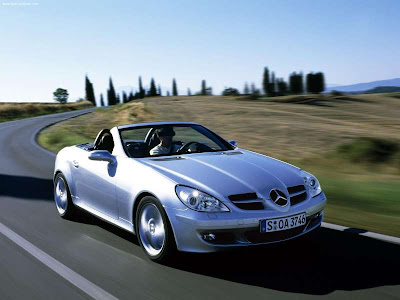







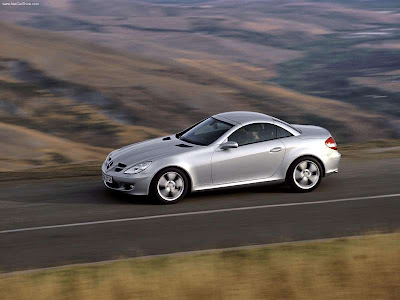
Mercedes-Benz SLK350
Mercedes-Benz SLK-Class R171
The SLK was updated in 2005 with a new Formula One-inspired appearance and serious performance. The new R171-platform SLK was again on Car and Driver's Ten Best list for 2005, and it won the Canadian Car of the Year Best New Convertible award. Highlighting its potential appeal to women, New Zealand's Lucire magazine announced it as its 'Car to Be Seen in' for 2005. The current SLK is also built in Bremen, Germany. There are rumours that Mercedes-Benz is going to produce a SLK 63 AMG model with their new 6.2L naturally aspirated automobile engine designed from scratch by AMG division.
Models of the new SLK include:
+ SLK 200 Kompressor - 1.8 L 120 kW (163 hp DIN) I4 supercharged engine, 0-100 km/h (62 mph) 7.9 seconds, top speed of 143 mph. (not available in Canada and the US)
+ SLK 280 - 3.0 L (2996 cc) 170 kW (231 hp DIN) double overhead cam V6 engine, 0-100 km/h (62 mph) 6.3 seconds, top speed 155 mph. (starting in 2006 model year)
+ SLK 350 - new 3.5 L (3498 cc) 200 kW (272 hp DIN) double overhead cam V6 engine, 0-100 km/h (62 mph) 5.4 seconds, top speed 155 mph (electronically limited).
+ SLK 55 AMG - 5.5 L (5439 cc) 265 kW (360 hp DIN) V8 engine, 0-100 km/h (62 mph) 4.8 seconds, top speed 155 mph (electronically limited). A tuned version of this is used as the Formula One safety car.







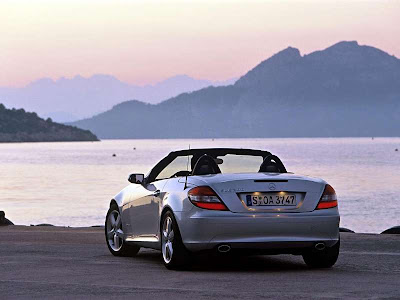
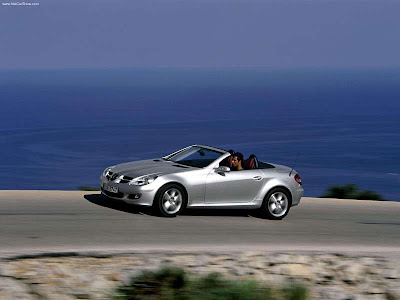
Mercedes-Benz SLK200 Kompressor
Mercedes-Benz SLK-Class R171
The SLK was updated in 2005 with a new Formula One-inspired appearance and serious performance. The new R171-platform SLK was again on Car and Driver's Ten Best list for 2005, and it won the Canadian Car of the Year Best New Convertible award. Highlighting its potential appeal to women, New Zealand's Lucire magazine announced it as its 'Car to Be Seen in' for 2005. The current SLK is also built in Bremen, Germany. There are rumours that Mercedes-Benz is going to produce a SLK 63 AMG model with their new 6.2L naturally aspirated automobile engine designed from scratch by AMG division.
Models of the new SLK include:
+ SLK 200 Kompressor - 1.8 L 120 kW (163 hp DIN) I4 supercharged engine, 0-100 km/h (62 mph) 7.9 seconds, top speed of 143 mph. (not available in Canada and the US)
+ SLK 280 - 3.0 L (2996 cc) 170 kW (231 hp DIN) double overhead cam V6 engine, 0-100 km/h (62 mph) 6.3 seconds, top speed 155 mph. (starting in 2006 model year)
+ SLK 350 - new 3.5 L (3498 cc) 200 kW (272 hp DIN) double overhead cam V6 engine, 0-100 km/h (62 mph) 5.4 seconds, top speed 155 mph (electronically limited).
+ SLK 55 AMG - 5.5 L (5439 cc) 265 kW (360 hp DIN) V8 engine, 0-100 km/h (62 mph) 4.8 seconds, top speed 155 mph (electronically limited). A tuned version of this is used as the Formula One safety car.






Mercedes-Benz F 600 Hygenius Concept
F 600 HYGENIUS: premiere at the Tokyo Motor Show: Power, comfort and zero emissions: Mercedes-Benz presents new research vehicle with fuel cell drive
The new F 600 HYGENIUS is the latest in the series of research vehicles from Mercedes-Benz that point the way forwards for the future. Powered by a zero-emission fuel cell drive with an output of 85 kW/115 hp, the compact-class car with a family-friendly design consumes the equivalent of 2.9 litres of fuel per 100 kilometres and has an operating range in excess of 400 kilometres. "This represents a major step towards bringing the fuel cell drive up to full production maturity, a goal that we aim to achieve some time between 2012 and 2015," remarks Dr. Thomas Weber, DaimlerChrysler AG Board Member for Research & Technology and Head of Development at the Mercedes Car Group. "By developing the fuel cell, we are creating a new basis for supplying energy in tomorrow's vehicles which will make a further lasting improvement to their environmental compatibility." In addition to the fuel cell technology, the Mercedes-Benz research vehicle also showcases an operating concept with virtual displays, new-style seats and other pioneering technologies designed to enhance safety and passenger comfort.
Fuel cells use the chemical reaction between hydrogen and oxygen to generate electrical power in a process that produces no emissions. Professor Herbert Kohler, Director of Vehicle Body and Drive Research at DaimlerChrysler: "We have made some crucial advances to this trailblazing technology. The fuel cell in the F 600 HYGENIUS is around 40 per cent more compact than previously, runs more efficiently than ever and is notable for its good cold-start characteristics. This has been achieved thanks to the inclusion of innovations such as the redesigned fuel stacks, an electric turbocharger and a new humidification and dehumidification system."
The F 600 HYGENIUS achieves a maximum power output of 85 kW/115 hp combined with a peak torque of 350 Newton metres. The fuel cell drive alone generates a constant power output of 60 kW/82 hp and a torque of 250 Newton metres. With any surplus energy being stored in a powerful lithium-ion battery, the system acts in a similar fashion to a hybrid drive, selecting the best power source to use depending on the driving situation. When parking or manoeuvring, for instance, the electric motor draws its power from the battery alone, while both fuel cell and battery feed it with energy in unison when the vehicle is accelerating. The electric motor doubles as a generator that charges the battery during vehicle braking by recuperating drive energy.
Mobile power station supplies energy both at home and away
As well as generating clean energy to drive the research vehicle, the fuel cell can also serve as a mobile power source: its 66 kW of electrical power would be quite sufficient to keep several detached houses supplied with power.
Passengers aboard the F 600 HYGENIUS also stand to benefit from its extraordinary energy reserves: the cup holders which use electrical power from the fuel cell to keep drinks chilled or hot are just one example of this. The fuel cell's energy also allows electrical devices to be operated anywhere at the standard voltage level - following onboard conversion - granting the occupants total independence from the mains network on family outings or business trips. All they have to do is connect the device to a power socket in the tailgate.
Compact-class car boasting luxury-class spaciousness
The four-door F 600 HYGENIUS also makes a mark for itself when it comes to comfort and versatility. Despite the body's compact length of just 4348 millimetres, the levels of space inside are impressive, even by luxury-class standards. The distance between the front and rear seats - a useful indicator of the freedom of movement and spaciousness - measures 945 millimetres, and can be extended by up to a further 400 millimetres thanks to the sliding design of the individual rear seats. This puts the research vehicle's comfort dimensions on a par with those found in exclusive luxury saloons.
Seating concept offering families the versatility they are looking for
A host of ingenious design solutions make the F 600 HYGENIUS an ideal family car. Take the child and family-friendly design of the seats, for example: the front passenger seat and the individual seats in the rear incorporate a new technology allowing the backrest to be used either way around. The backrests can be swung forwards and reversed in such a way that ISOFIX child seats can be locked into place on the seat cushions in a rearwards-facing position. The face-to-face seating arrangement boosts safety at the same time as making it easier to attend to young children en route, with the additional fore-aft and crossways adjustment of the rear seats allowing infants to be reached easily from the nearside rear seat.
Mercedes-Benz has devised a revolutionary new seat for the driver featuring a two-piece backrest cushion that follows the upper body movements and minimises the strain on the intervertebral discs, regardless of the seat position. If, for instance, the driver tilts the seat further back, the lower section of the backrest cushioning automatically pivots forwards to support the pelvic area.
Video cameras for leaving the vehicle and changing lane safely
Cameras integrated into the housings of the exterior mirrors keep an eye on traffic to the side of and behind the F 600 HYGENIUS, even when it is parked. If another car or a bicycle is approaching from behind, the system will automatically disable the doors for a brief period to avoid the risk of a collision when they are opened. Out on the road, the video system monitors the blind spot of both exterior mirrors and warns drivers about to change lane if a vehicle is approaching from behind.
Space-saving opening mechanisms for doors and tailgate
The tailgate of the F 600 HYGENIUS has a two-piece design offering maximum practicality. If space is at a premium, the tailgate's lower section is automatically folded inwards so that the tailgate swings through a much tighter arc as it opens. As this is happening, the rear bumper drops down, pulling out the floor plate of the luggage compartment at the same time to simplify loading. The front doors of the latest Mercedes research vehicle also boast a technology that is designed to make getting into and out of the vehicle as easy and convenient as possible when parked in tight spaces: the doors swing upwards at a slant, meaning that they take up less space to the side when opening than conventional car doors.
Two-level operating concept with sophisticated new user recognition facility
In order to allow the vast multitude of functions to be operated quickly, intuitively and, most importantly, safely, the engineers at Mercedes have devise a concept based on the proven operating principle used in the new Mercedes-Benz S Class. This concept helps to minimise driver distraction, which in turn benefits driving safety. As in the Mercedes flagship model, buttons in a control panel in the middle of the dashboard serve to operate the most commonly used systems, such as the radio, air conditioning, car phone and navigation. These buttons can be easily reached by both the driver and the front passenger.
The push/turn control knob in the centre of the control panel can automatically detect whether it is being operated by the driver or the front passenger, enabling both to program their personal climate control settings. This intelligent user recognition facility is based on the electrical signals transmitted in the skin: the instant the front passenger touches the push/turn control knob in the centre, a data circuit closes between the control knob and a sensor mat in the seat cushion, switching the display to the settings for the front passenger side.
For advanced operating functions, the COMAND controller developed for the new S-Class extends out of the armrest between the front seats and allows straightforward navigation through the COMAND system's control menus.
Virtual displays for fast vision adjustment
The images on both high-resolution colour displays in the dashboard are diverted by means of two mirrors before being projected to appear at a point 1.40 metres in front of the driver. This leading-edge virtual display technology from Mercedes-Benz represents a key improvement to driver-fitness safety as it shortens the time required for drivers to switch their gaze from what's taking place on the road far ahead to the close-up instrument cluster display. Scientific studies have confirmed that, with this technology, the driver's eyes do not have to constantly adjust between close and long range so they do not tire as quickly.
High-power light-emitting diodes for all lighting functions
Headlamps with high-power LEDs enhance the driver's night-time vision and help to avoid accidents. The LEDs are distributed over three projector modules: the light module in the centre is activated as required, depending on the driving situation, and also assumes additional functions, such as main beam, the Active Light System and the cornering light. All of the various lighting features are performed simply by switching individual LEDs on and off electronically, thereby eliminating the need for moving components, such as those currently fitted for the Active Light System.
Preventive PRE-SAFE® system with knee bolster plus new head restraints
The preventive occupant protection system PRE-SAFE®, which was first premiered in the Mercedes-Benz S-Class in 2002, will continue to be expanded by Mercedes engineers in future. Two additional anticipatory protective functions have been incorporated aboard the F 600 HYGENIUS: active knee protection to brace the front passenger plus head restraints with automatically extending side bolsters to hold the head still. These new features are triggered together with the other PRE-SAFE® measures prior to an impending accident, to prepare both occupants and vehicle for a collision.









Mercedes-Benz E350 with Sports Equipment
Mercedes-Benz E-Class W211
The Mercedes-Benz E-Class is a mid-size luxury car / executive car sold by the Mercedes-Benz branch of DaimlerChrysler. The model line is available with various six and eight-cylinder petroleum gasoline and diesel engines. The E stood for Einspritzung, which is German for fuel injection, which was a very new feature at the time the "E" first appeared in the 1950s. The E-Class is the bestselling Mercedes-Benz model worldwide. It is famous both as luxury or executive transport, and as taxis in countries like Germany and Singapore. In Germany the E-Class is also commonly used as a police interceptor vehicle.
The Mercedes-Benz W211 cars entered production in 2003. They are sold under the E-Class model names. The W211 models replaced the W210 E-Class models.
The W211 E-Class continues the line's push upmarket. The W211-based W219 CLS-Class was new for 2005. In 2002 Mercedes made a facelift for the W210 which begun the launch of the W211.
2006 update
The W211 E-Class was facelifted for 2007, although a new model is less than two years off. Mercedes-Benz called this a "new generation" in their press release, but the changes are mainly superficial and engine-related. The Pre-Safe system was made standard in sedan and wagon models, Neck-Pro safety headrests are added, and Mercedes' blinking brake lights, provisionally approved for use in the United States, are also new. The "Intelligent Light System" is an adaptive headlight system with five different lighting combinations rather than the two found on most cars.
Six of the ten engines available on the W211 were also changed. The four-cylinder Diesel engine in the E200 CDI and E220 CDI was substantially modified for more output. The E320 CDI is updated with Bluetec technology. Mercedes-Benz introduced their Bluetec Diesel system to the E-Class at the 2006 North American International Auto Show as the E320 Bluetec. This system with 'AdBlue' injection uses urea to clean Diesel emissions, the E-Class however only uses an oxidising catalyatic converter and particulate filter combined with nitrogen oxide reducing systems, this alone makes the E320 45-state legal in the United States (The 'Vision GL320 Bluetec' will be 50-state compliant, as it uses 'AdBlue'). Sales begin in autumn 2006 as a 2007 model.
The North American E500 becomes the E550, and the E63 AMG is introduced as well.

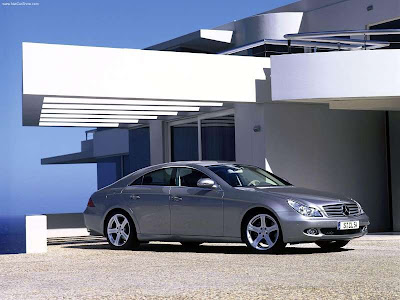







Mercedes-Benz CLS500
Launch of a new Mercedes model series - CLS-Class: Four-door Coupé a generation ahead
Stuttgart, Sep 07, 2004
At the beginning of October 2004 the new Mercedes-Benz CLS-Class four-door Coupé is being given its market launch. The car is based on a unique vehicle concept which for the first time combines the elegance and dynamism of a coupé with the comfort and practicality of a saloon. Spaciousness, luggage capacity and day-to-day practicality are at the level of a saloon, while the design lines possess the emotionally charged character of a coupé. With this currently unique combination, the new CLS-Class is one coupé generation ahead.
The technical specification also points the way to the future: in addition to adaptive front airbags, sidebags and windowbags, the preventive occupant protection system PRE-SAFE is to become available for the new Mercedes Coupé in the near future. The engine range includes two powerful petrol units: in the CLS 350 a newly developed V6 with 200 kW/272 hp and in the CLS 500 a muscular eight-cylinder unit with 225 kW/306 hp. Both engines are partnered by the new seven-speed automatic transmission, 7G-TRONIC, as standard. In the top CLS 500 model features such as AIRMATIC DC air suspension and THERMOTRONIC four-zone climate control provide S-Class levels of comfort.
The precursor to the new CLS-Class was a coupé study which Mercedes-Benz presented at the Frankfurt Motor Show in autumn 2003. The enthusiastic public response to this four-door coupé encouraged the management in Stuttgart to give the green light for series production.
As a unique synthesis of a coupé and a saloon, the new CLS-Class offers a great deal more added value than other coupés. In this way Mercedes-Benz is once again emphasising its role as a trendsetter for new ideas in the automotive world. The sophisticated aesthetics of this coupé design, the exclusive appointments and the trailblazing technology are particularly aimed at people who have a passion for motor cars and motoring.
Comfort and spaciousness to saloon standards
The four-door coupé concept even allows passengers in the rear convenient access and egress. They have the benefit of two comfortable single seats and enjoy generous freedom of movement. There is a distance of 829 mm between the front and rear seats, which together with the shoulder and elbow-level width (1422 and 1464 millimetres respectively in the rear) puts the CLS-Class firmly in saloon territory. Newly developed seats with electric adjustment as standard are available for the driver and front passenger; on request these can be equipped with active ventilation or as a dynamic multicontour seat.
Furthermore, the boot of the new CLS-Class holds up to 505 litres (VDA measuring method) - much more than any other coupé and even many a saloon.
Choice of powerful six and eight-cylinder engines
Both the engines available for the CLS-Class exhibit effortless performance and exemplary torque characteristics, providing the best possible conditions for dynamic driving pleasure. The CLS 350 is equipped with a newly developed V6 engine which has an output of 200 kW/272 hp and delivers its maximum torque of 350 Newton metres from a mere 2400 rpm. Both are peak values in this displacement class.
The six-cylinder Coupé accelerates from standstill to 100 km/h in 7.0 seconds and reaches a maximum speed of 250 km/h. The lively V6 engine harmonises with the likewise new 7G-TRONIC seven-speed automatic transmission, which is standard equipment. This is the world's first passenger car transmission of this type, and makes a major contribution to the strong acceleration and exemplary fuel consumption of the CLS 350 - 10.1 litres per 100 kilometres (NEDC combined consumption).
Standard appointments in the six-cylinder Coupé include THERMATIC automatic climate control, a stereo radio, speed-sensitive power steering, a leather-covered steering wheel, 17-inch light-alloy wheels and 245/45 R 17 wide-base tyres.
With the 5.0-litre V8 engine the new CLS 500 need fear no performance comparison with thoroughbred sports cars, while offering the eight-cylinder comfort typical of a luxury-class saloon. This power unit has an output of 225 kW/306 hp and an impressive 460 Newton metres of torque. Once again the standard seven-speed automatic transmission plays its part here. The CLS-Class V8 Coupé accelerates from standstill to 100 km/h in 6.1 seconds. The fuel consumption is 11.3 litres per 100 kilometres (NEDC combined consumption).
The additional standard equipment in the CLS 500 (as compared with the CLS 350) includes AIRMATIC DC air suspension, THERMOTRONIC luxury climate control and 18-inch light-alloy wheels with 245/40 R 18 wide-base tyres.
Occupant protection with adaptive airbags and PRE-SAFE
The new CLS-Class is equipped with the latest safety systems such as adaptive front airbags, windowbags and sidebags, as well as belt tensioners and belt force limiters on all seats, offering an extremely high level of occupant protection. In future the prize-winning Mercedes safety system PRE-SAFE will be available. In critical driving situations this system activates precautionary measures for the vehicle occupants. These measures include split-second tensioning of the seat belts, which brings the driver and front passenger into a more favourable seating position even before a potential collision. This enables the airbags to protect the occupants more effectively if an impact occurs.
Leading-edge Mercedes technology for handling safety and superb comfort
In the field of handling safety Mercedes-Benz emphasises its technological leadership among car brands in the new CLS-Class with Sensotronic Brake Control SBC™ and the latest-generation Electronic Stability Program (ESP®) as standard. A number of other innovations are also optionally available for the four-door Coupé to make driving even safer. These include powerful bi-xenon headlamps with Headlamp Assist, which Mercedes-Benz now combines with cornering lights.
DISTRONIC proximity cruise control, LINGUATRONIC voice control, the control and display system COMAND APS with Europe-wide DVD navigation and the access and drive authorisation system KEYLESS-GO are further optional Mercedes innovations which guarantee even greater comfort and even more driving pleasure.


















































